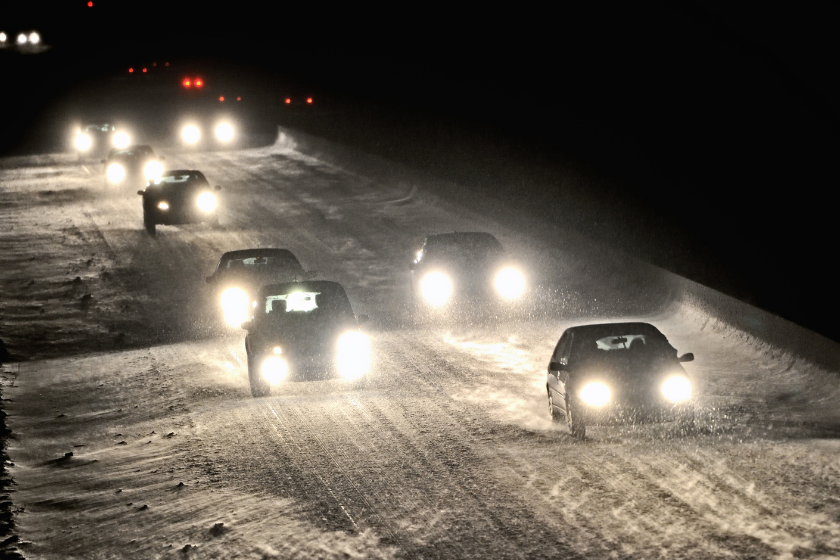Remember being a kid, enjoying long evenings with friends, doing whatever you wanted to do when the sun came down? And how parents always put a damper on the fun by saying, "We need to leave before sun down so we don't have to drive after dark."
As a kid, we figured that this was just a way of exercising further control on our budding independence. But, as adults, it make sense. Driving at night sucks, whether it's on a highway, congested downtown area, or even a seemingly safe and empty rural area.
It's an actual fact that night driving is more difficult than driving during the day. Every car's headlights are either too bright or too dim. There are nocturnal road-hopping critters to be wary of. Not to mention terrible weather conditions or motorists who don't want to stay on their side of the road. More fatal accidents happen between 6 p.m. and 6 a.m. as opposed to daylight hours.
Driving after dark may seem like an endless nightmare of blinding oncoming lights and invisible road signs, but there are a few things you can do to keep yourself safe.
Defensive Driving Tips for Night Driving

Photo by PHILIPPE HUGUEN/AFP via Getty Images
Follow the Speed Limit
Yes, we saw you roll your eyes. Unless you're fully rested and ready to go, your reaction time isn't going to be as fantastic as you'd like it to be.
If you need to slam on the brakes or do some professional-grade swerving due to another driver or an animal in the road, you're going to need plenty of time to think and act.
A following distance of three seconds between you and the vehicle in front of you is recommended, but consider increasing this at night.
Keep Your Eyes Focused on the Road Ahead
Bright lights can make your depth perception do funky things.
The lights of oncoming traffic can become distorted by glare caused by modern LED and high-intensity lights bouncing off of your windshield. After a slew of oncoming drivers, you might even feel eye pain or a slight headache.
Try not to look directly at the headlights, keeping your eyes instead on the lane marker or the edge marker.
Dim Your Interior Lights
Make sure your interior lights are on a dimmer setting, too.
Your eyes can have trouble focusing between bright dash lights, street lights, and the lights of an oncoming car, which can fatigue your eyes as much as high beam headlights pointed in your direction.
Clean Your Windows
Speaking of interiors, clean your windows.
Any grime built up on the inside or outside of your windshield and rear window can further distort the lights from oncoming vehicles, so make sure your windshield wipers are in good, working order, fill up your wash tank, and keep some paper towels or napkins handy to clean off the inside if it gets filthy or foggy.
Safety Tips for Driving After Dark

Photo by Getty Images
As a driver, there are some things you can do for yourself to improve your nighttime driving skills.
Avoid drowsy driving. Your alertness and attention to the road can be highly impaired not just by alcohol or drugs, but by just being plain old exhausted. Your eyesight can blur, your reaction times get slower and slower, and your mind wanders off. You may even drift off to sleep behind the wheel.
According to the National Highway Traffic Safety Administration (NHTSA), around 100,000 accidents related to drowsiness occur each year. Many of these result in fatalities
Some new cars offer safety features that track driver attention and sound an alert or vibrate the driver's seat if the car detects a lack of focus. Lane keep assist can prevent you from swerving off the road or into oncoming traffic. But, nothing can take the place of being awake and alert behind the wheel.
This next tip isn't intended to insult anyone, so let's just lay it out there: when was the last time you visited the eye doctor?
As we age, our night vision tends to get weaker. Our peripheral vision can dwindle away, and depth perception, even in ideal daylight, can become confusing.
The American Optometric Association recommends having your vision checked every three years, or every two years after the age of 60. Having the right corrective lenses is crucial for safe driving, and today's anti-reflective coating on glasses can help combat the glare from oncoming headlights.
When it comes to driving at night, it's best to play it safe. Everything from oncoming headlights to bad weather to creatures in the road can be more dangerous at night, when reaction time is compromised and vision is weakened.
While it would be great to not drive at night, that's not a reality many of us can expect. These tips can help you ride the safe side so you can get where you're going whenever you need to be there.
Products featured on Alt_driver are independently selected by our editors. However, when you buy something through our links, we may earn a commission.
This post was originally published on August 2, 2021.
